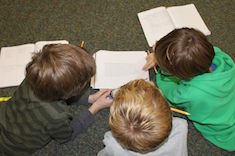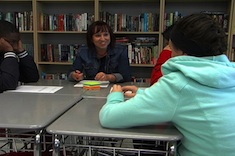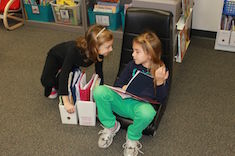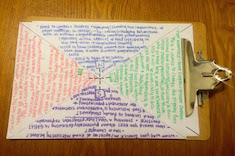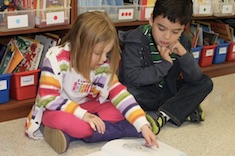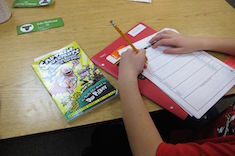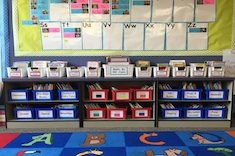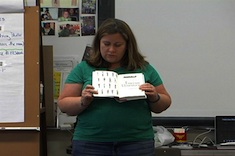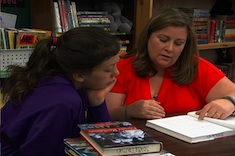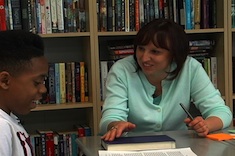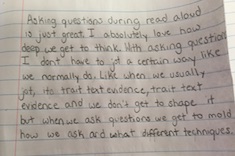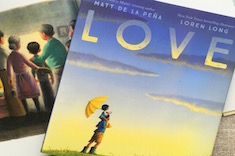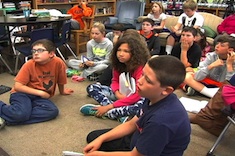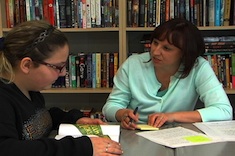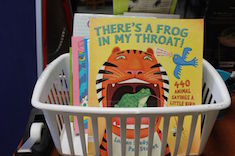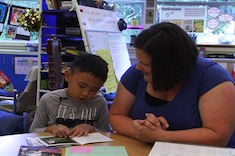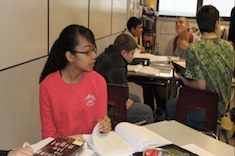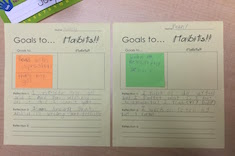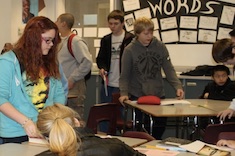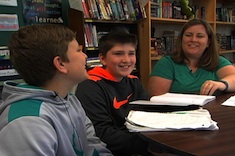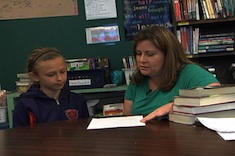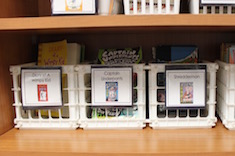Teaching Reading
Our contributors lead reading workshops in classrooms with creative flair. Over the past 12 years, we've filled our site with loads of suggestions, tools, and tips for using engaging books throughout the curriculum to hook kids on reading. Here is where you will find many stories of successful and not-so-successful workshop days, and what we learned from them. We bring these stories to life through hundreds of video examples.
Latest Content
Launching a Historical Fiction Genre Study
Tara Smith finds her sixth graders love historical fiction, but they often lack the background knowledge to understand texts fully. She launches her historical fiction unit with a careful mix of discussion, anchor charts, and shared texts.
Content and Context
Melanie Meehan considers content and context for students who struggle to master new skills because of a lack of background knowledge.
Using a Storyboard for Reflection and Comprehension
Christy Rush-Levine shows a group of three students how they can use a storyboard to help track thinking while reading.
Talk Guide
Gigi McAllister presents a guide to her fourth-grade students to improve talk in reading trios.
Improving Turn-and-Talks
Melanie Meehan shares questions and reflection prompts to make the turn-and-talk strategy more effective.
Compass Points and Empathy
Andrea Smith uses the “compass points” strategy to provoke better whole-class discussions and reflection during read alouds.
Authentic Reading in Kindergarten
Dana Murphy realizes the best way to introduce students to reading in kindergarten is to apply the principles that work at home with her own children.
Summer Reading
Bitsy Parks reflects upon her own not-so-successful experiences as a parent in getting her four children to read during the summer months. She uses these parenting lessons to help students take the initiative for summer reading by writing down commitments and goals in her first-grade classroom.
Reimagining Reading Logs
Reading logs have fallen out of favor in many classrooms because they often become a rote activity for recording pages read. Tara Barnett and Kate Mills find authenticity with the logs comes when they move from emphasizing recording to goals and reflection.
Weeding a First-Grade Library
Bitsy Parks has a simple seven-step process for a hard day’s work of weeding out her first-grade classroom library.
Book Talk: “The Last Fifth Grade of Emerson Elementary”
Katherine Sokolowski demonstrates her book talk skills when she presents The Last Fifth Grade of Emerson Elementary to her students late in the school year.
Building a Next-Read Nonfiction Stack
Katherine Sokolowski helps fifth grader Jack build a next-read stack of nonfiction, highlighting a variety of text features and historical references.
A Community Reads “Wonder”
Katherine Sokolowski had a dream — her whole community reading and celebrating the same book. She explains how she helped coordinate, organize, and purchase hundreds of books for a community-wide reading of Wonder.
Peer Support in Writing Workshop: Conferring with Jaden
Christy Rush-Levine meets with eighth grader Jaden, who talks through his struggles in writing a conclusion to his literary analysis, and how his peers helped him improve the writing.
Choose Your Own Grammar Adventure
Gretchen Schroeder shares a quick exercise she’s developed for her high school students to hone grammar and editing skills using online video resources and individual Chromebooks.
Questioning Within Read Alouds
Melanie Meehan looks at the issue of engagement through the lens of student questions during read alouds, and shares a strategy to provoke more thoughtful student participation.
Leveraging Read Aloud
Christy Rush-Levine finds that administrators are questioning the value of read alouds, especially with older students. She shares how she uses the picture book Love in her middle school classroom to launch challenging discussions about timely themes.
Big Question Minilesson
Katherine Sokolowski models how readers make choices as questions arise while reading independently. She also demonstrates how she moves between a novel and web resources.
One Text, Many Lessons
Tara Barnett and Kate Mills share how one book can serve as an anchor for lessons on everything from writer’s craft to test-taking skills.
Close Attention and Reading Response: Conferring with Tori
Christy Rush-Levine confers with eighth grader Tori about her reading response to Why We Broke Up. She encourages Tori to make connections between the characters in her current book and her previous reading by paying close attention to surprising action.
Revising Thinking Through Multiple Readings
We’ve all had that student — the one who blurts out a misreading of a text, only to have classmates agree with the analysis. Christy Rush-Levine explains how she uses “first-, second-, and third-draft readings” to help her middle school students develop stronger comprehension skills.
Questions for Rereaders
Lifelong readers often have books they love to reread, sometimes more than once. But young readers can also get into ruts. Jennifer Schwanke explores when rereading is fine for students, and when it should be challenged. She includes a series of questions for teachers to use when conferring with children who are rereading favorite books.
Bin of the Week
Shari Frost and a teacher she is assisting notice some bins collecting dust in the classroom library. When the teacher resists removing the books, they work together to find creative ways to help students develop enthusiasm for neglected series and authors.
Why Bother? Practical Answers to Questions About Close Reading
Why bother with close reading? Jennifer Schwanke finds many teachers asking themselves if close reading is worth the time, when schedules are already overstuffed. She shares some prompts to help assess when close reading makes sense.
Stop and Inquire
Mark Levine capitalizes on what captures his middle school students’ attention with his Stop and Inquire routine.
Goals to Habits in First Grade
Bitsy Parks finds goals aren’t enough for her first-grade students—real growth requires that the goals eventually become habits. She develops a process mid-year to help children refine their goals step-by-step.
Flash Forward with New Students
The dark days of winter may be the best time to plan for spring step-up events to introduce students to next year's teachers. Christy Rush-Levine has a new goal of using the day to promote summer reading.
Teaching Fifth Graders to Make Peer Recommendations
Katherine Sokolowski confers with her son Liam and his friend Caden, helping them learn how to make peer book recommendations.
“If You Like” Reading Recommendations Conference
Building "next-read" stacks with students before holidays is a great way to ensure they have books in hand that they will be excited to read over break. Katherine Sokolowski helps Taryn finds books that are similar to those written by Rick Riordan (Taryn's favorite author).
Reaction and Intention: Rethinking the Library in Early Winter
Mary Lee Hahn finds some of her fifth-grade readers are stuck in ruts by early winter. Her solution involves some radical changes to her classroom library over winter break.
Browse Content By
Type
Category
- Assessment Tools
- Big Fresh Archives
- Booklists
- Choice Numeracy
- Classroom Design
- Common Core
- Community Building
- Conferring
- Content Literacy
- Digital Literacy
- English Language Learners
- Equity
- Family Relations
- Free Samples
- Guiding Groups
- Leadership
- Literacy Coaches
- Mentor Texts
- Minilessons
- New Teacher Mentors
- Podcasts
- Poetry
- Quote Collections
- Reading Strategies
- Self Care
- Struggling and Striving Learners
- Talking and Listening
- Teacher Study Groups
- Teaching Reading
- Teaching Writing
- Word Study and Vocabulary
Author
- Melissa Quimby
- Nawal Qarooni
- Gwen Blumberg
- Julie Cox
- The Lead Learners
- Hannah Tills
- Josie Stewart
- Ruth Metcalfe
- Mallory Messenger
- Becca Burk
- Jodie Bailey
- Vivian Chen
- Mary Brower
- Tiffany Abbott Fuller
- Stephanie Affinito
- Ruth Ayres
- Leigh Anne Eck
- Heather Fisher
- Shari Frost
- Julie Johnson
- Suzy Kaback
- Gigi McAllister
- Shirl McPhillips
- Melanie Meehan
- Cathy Mere
- Debbie Miller
- Tara Barnett and Kate Mills
- Tammy Mulligan
- Dana Murphy
- Bitsy Parks
- David Pittman
- Brenda Power
- Heather Rader
- Matt Renwick
- Mandy Robek
- Christy Rush-Levine
- Gretchen Schroeder
- Jen Schwanke
- Brian Sepe
- Katherine Sokolowski
- Stella Villalba
- Jennifer Vincent
Grade Level
Choice Literacy Membership
Articles
Get full access to all Choice Literacy article content
Videos
Get full access to all Choice Literacy video content
Courses
Access Choice Literacy course curriculum and training

